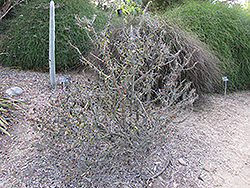It's all about ...
plants

Height: 15 feet
Spread: 15 feet
Sunlight:
![]()
![]()
Hardiness Zone: 9b
Description:
A spiny, woody shrub or small tree in the cactus family, primarily grown as an ornamental, but leaves and fruit are edible; purplish-pink flowers appear in summer, followed by fruit; vigorous and adaptable
Ornamental Features
Rose Cactus is a member of the cactus family, which are grown primarily for their characteristic shapes, their interesting features and textures, and their high tolerance for hot, dry growing environments. Like all cacti, it doesn't actually have leaves, but rather modified succulent stems that comprise the bulk of the plant, and which are designed to hold water for long periods of time. This particular cactus is valued for its upright and spreading habit of growth which can occur as either a single rough stem or grow as a cluster of such stems that spread out from a central base. This plant features showy fragrant pink daisy flowers with lavender overtones and yellow eyes along the branches from early summer to early fall, which emerge from distinctive hot pink flower buds. It features an abundance of magnificent yellow berries with red blush from mid fall to mid winter. The fruit can be messy if allowed to drop on the lawn or walkways, and may require occasional clean-up.
This plant is primarily grown as an ornamental, but it's also valued for its edible qualities. The round sweet fruit is most often used in the following ways:
- Fresh Eating
- Preserves
- Juice-Making
Landscape Attributes
Rose Cactus is a large succulent evergreen plant with an upright spreading habit of growth. It tends to form a colony of solitary stems that spread out and away from the base. As a type of cactus, it has no true foliage; the body of the plant is wholly comprised of one or more rough stems. With age, this plant will eventually develop a woody dark gray 'trunk' at its base.
This plant will require occasional maintenance and upkeep, and is best pruned in late winter once the threat of extreme cold has passed. However, secondary stems may be removed at the base to control the spread of the plant. It is a good choice for attracting birds, bees and butterflies to your yard, but is not particularly attractive to deer who tend to leave it alone in favor of tastier treats. Gardeners should be aware of the following characteristic(s) that may warrant special consideration;
- Spiny
Rose Cactus is recommended for the following landscape applications;
- Accent
- Hedges/Screening
- General Garden Use
- Naturalizing And Woodland Gardens
- Container Planting
Planting & Growing
Rose Cactus will grow to be about 15 feet tall at maturity, with a spread of 15 feet. It is often either grown as a solitary specimen or permitted to grow into a broader colony as part of a garden composition. It grows at a medium rate, and under ideal conditions can be expected to live for approximately 20 years.
This plant does best in full sun to partial shade. It is very adaptable to both dry and moist growing conditions, but will not tolerate any standing water. It is considered to be drought-tolerant, and thus makes an ideal choice for a low-water garden or xeriscape application. This plant should not require much in the way of fertilizing once established, although it may appreciate a shot of general-purpose fertilizer from time to time early in the growing season. It is not particular as to soil pH, but grows best in sandy soils, and is able to handle environmental salt. It is somewhat tolerant of urban pollution. This species is not originally from North America.
Rose Cactus is a fine choice for the garden, but it is also a good selection for planting in outdoor pots and containers. Its large size and upright habit of growth lend it for use as a solitary accent, or in a composition surrounded by smaller plants around the base and those that spill over the edges. It is even sizeable enough that it can be grown alone in a suitable container. Note that when growing plants in outdoor containers and baskets, they may require more frequent waterings than they would in the yard or garden. Be aware that in our climate, most plants cannot be expected to survive the winter if left in containers outdoors, and this plant is no exception. Contact our experts for more information on how to protect it over the winter months.
This plant is not reliably hardy in our region, and certain restrictions may apply; contact the store for more information.
